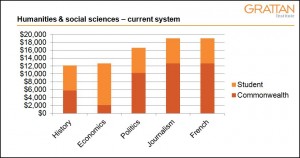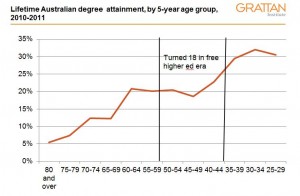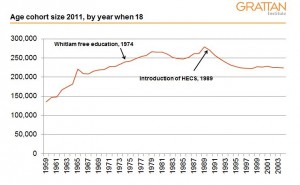Stories in the Fairfax papers this morning are talking about the doubling of fees for some arts degrees, to compensate for reduced government subsidies. That is only true of journalism courses, but the reason why these numbers are being arrived at are worth further examination.
The current system is based on funding a ‘unit of study’ (ie a subject) according to its field of education. Each field of education is allocated to one of eight ‘funding clusters’ that determine its ‘Commonwealth contribution’ (ie subsidy) and ‘student contribution’ (often called ‘HECS’). Universities set their own student contributions up to a maximum set by legislation, but in practice all charge the maximum amount.
As is common in the higher education system, various quirks of history rather than clear principles or policies explain these rates. As the figure below shows, this leads to very different overall funding rates for the subjects that someone enrolled in arts might take (I have adjusted 2014 rates up to $2016 for the comparison to come). In my view, only the foreign languages difference could obviously be justified by an inherent need for different teaching methods.

What the new Commonwealth contribution rates would do is bring the humanities and social science type subjects, except economics and languages, to a consistent level, as seen in the figure below. This means that humanities like history get a small increase in funding, while the others get a substantial cut.

From a first principles basis, the new rates look more consistent and rational than the rates they would replace.
If they go ahead (the government has signalled willingness to look at the detail of these cuts) do student contributions need to increase to take total funding per place back to current levels? Arguably, some of these disciplines have long been over-funded and there is scope to not simply maintain the funding status quo by passing on all reductions in Commonwealth contributions to students.
Overall, however, the ‘revenue theory of costs’ is likely to explain university operations more than any strict relationship between what it should reasonably cost to deliver a course and what it actually does cost. It’s Bowen’s law: universities raise all the money they can, and spend all the money they raise. No matter how much money they have, they always feel ‘under-funded’ because they let their costs increase to absorb any previous funding boost. This is why even absurdly rich universities like Harvard feel the need to do major fundraising campaigns.
So while some disciplines look over-funded relative to similar disciplines, it is likely that much of this extra funding has been built into expenditure over time (even if profits in some disciplines have been redistributed to other university activities). While they might not pass on all the Commonwealth contribution reduction to students, the internal trauma involved in reducing costs means that there are likely to be substantial student contribution increases.
One reason I am keen on opening the higher education system up to competition is that I want to bring in new players without these legacy cost structures, who I hope will be able to provide the same or better services than the universities while charging students lower fees.









Recent Comments